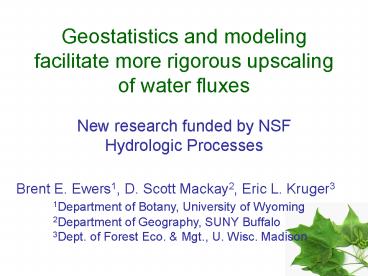Geostatistics and modeling facilitate more rigorous upscaling of water fluxes
1 / 20
Title:
Geostatistics and modeling facilitate more rigorous upscaling of water fluxes
Description:
2Department of Geography, SUNY Buffalo. 3Dept. of Forest Eco. & Mgt., U. Wisc. Madison ... Current models of water loss and carbon uptake adequately portray ... –
Number of Views:33
Avg rating:3.0/5.0
Title: Geostatistics and modeling facilitate more rigorous upscaling of water fluxes
1
Geostatistics and modeling facilitate more
rigorous upscaling of water fluxes
- New research funded by NSF Hydrologic Processes
Brent E. Ewers1, D. Scott Mackay2, Eric L.
Kruger3 1Department of Botany, University of
Wyoming 2Department of Geography, SUNY
Buffalo 3Dept. of Forest Eco. Mgt., U. Wisc.
Madison
2
Problem Statement
- Current models of water loss and carbon uptake
adequately portray changes in time but only
operate at a point in space - Six publications concerning water fluxes from
ChEAS - Point measurements may lead to biased model
parameterizations - Limited data show that transpiration changes at
stand edges, most likely due to nonlinear
physiological controls on fluxes - Such nonlinearites change model parameterizations
near stand edges - Resulting uncertainties in model parameterization
will most likely be manifested as uncertainty in
water (and carbon) flux predictions at scales gt
10 m2 (stand level)
3
Stomatal Conductance is the key to Water Loss and
Carbon Uptake
GSGSmaxf(D), f(Qo), f(TL) stomatal conductance
is influenced by env. conditions (Jarvis
1976)
GSKL/D(?S- ?L) stomatal conductance is limited
by water (Whitehead et al 1984)
Relative Response
Relative Vapor Pressure Deficit
4
3 of 7 Species Have No change in Transpiration
Three Species Have the Same Daily Average
Transpiration and Response to VPD Over Two Years
5
Sugar Maple Transpiration Increases with Leaf Area
Hay Creek Northern Hardwoods are Recovering from
Thinning LAI increases from 3.5 to 4.6
6
Leaf Area Dynamics Are Large in Red Pine
Red Pine Transpiration Doubled and Leaf Area
Index Increased 30 Within Season Leaf Area
Trends Follow Residual Patterns
7
Trembling Aspen Was Completely Defoliated in 2001
Neither Transpiration Nor Leaf Area Completely
Recovers from Defoliation
defoliation
8
White Cedar and Dry Fir Transpiration Dynamics
White Cedar Transpiration is Correlated to Water
Level and Dry Fir is Inversely Correlated to
Aspen Transpiration
9
Water Potentials
Canopy Stomatal Conductance Model GSKL(1/D)(?S-
?L) GS canopy stomatal conductance KLleaf
specific hydraulic conductance Dvapor pressure
deficit ?Ssoil water potential ?Lleaf water
potential
Despite Increases and Decreases in Transpiration,
Diel Water Potentials Remain the Same
10
Universal Relationships
Plants regulate leaf water potential to just
prevent runaway cavitation
m 0.6 (sensitivity to D)
11
Cookie-Cutter Approach to Scaling Up
Complex landscape simplified to four cover
types-hardwoods, conifers, wetlands, aspen
12
Landscape scale water fluxes
Cookie-cutter approach works but is it for the
correct reasons??
13
Spatial Gradient Approach
GSref f(L, edge distance, wetland distance) m
0.6GSref
14
Edge-Effects on Canopy Transpiration
Transpiration at the edge of the stand is about
50 percent higher than transpiration at the stand
center.
- Contributing Factors
- radiation
- wind
- soil moisture
- nutrients
15
Hypothetical Scenarios
- Current forest
- Spatially uniform GSref in each forest patch
- Spatially variable GSref along gradients from (1)
closed forest to open areas, and (2) uplands to
wetland margins - Hypothetical forest with hardwoods removed
- Repeat spatially uniform and variable GSref
simulations
16
Conifers
Upland
Wetland
Aspen
Upland
Wetland
17
Conifers
Upland
Wetland
Aspen
Upland
Wetland
18
Diurnal Simulations
Center-of-Stand Basis
Spatial Gradient Basis
Transpiration mm (30-min) 1
19
Overall Changes
Current forests Spatial-Stand 10 overall
transpiration increase Hardwoods removed
Spatial-Stand 24 overall transpiration
increase
20
Conclusions
- Forest fragmentation increases the bias in
predicted canopy transpiration from
center-of-stand approaches. - Simulations indicate biases representing about 15
percent of growing season precipitation if
current forest management practices continue. - A large part of this bias is due to plasticity in
canopy stomatal conductance of aspen. - Comprehensive set of intensive and spatially
extensive transpiration flux measurements will be
made later this summer to test these concepts.






























